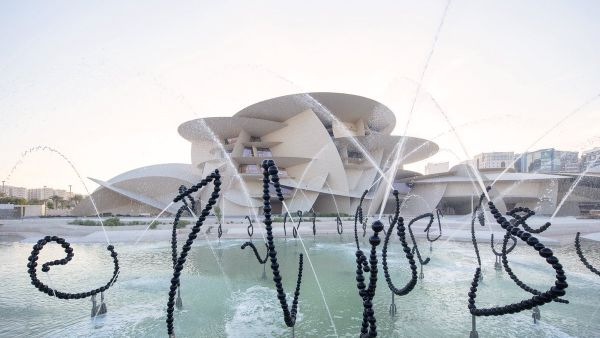The new National Museum of Qatar opened its doors to the public Thursday, unveiling a highly-immersive experience spotlighting Qatari heritage and culture.
Housed in a sprawling 52,000-square-meter spectacle by Pritzker Prize-winning French architect Jean Nouvel, the museum’s circular 1.5-kilometer path meanders through 11 galleries, each telling a part of Qatar’s history, taking visitors from the formation of the Qatar peninsula millions of years ago to today.
The galleries comprise three chapters “Beginnings,” “Life in Qatar,” and “The Modern History of Qatar” each exhibiting oral histories, archaeological and heritage objects, commissioned artworks and art films projected on monumental scale.
Child education corners allow younger visitors to interact with the collection through games and touch-based learning. The galleries include tactile and braille elements and, if the many touch-screen information tables weren’t enough, a phone app audio guide is also available.
“[We] knew we wanted to create a living experience for our people,” NMoQ director Sheikha Amna bint Abdul-Aziz bin Jassim Al-Thani, said at a news conference, “a museum with a heart.
“We have created galleries ... to engage our public fully, with their senses and emotions, as well as their intellects,” she added. “To develop the content of NMoQ, we [invited] Qataris to share whatever stories and materials they might care to offer.”
More than 400 people attended, she said. “We asked them to tell us what they most wanted to see and hear in NMoQ. From them came a richness of information, of life, that became the essence of NMoQ.”
NMoQ also commissioned local and international artists to create new works, installed inside and on the expansive grounds.
Installed outside the museum entrance, Simone Fattal’s sculpture “Gates of the Sea” is inspired by the ancient petroglyphs found at the Al-Jassasiya rock carvings.
To inaugurate its gallery for temporary shows is “Making Doha 1950-2030,” a display exploring the city’s urban and architectural development, on view through Aug. 30.
Curated by Rem Koolhaas and Samir Bantal of the Office for Metropolitan Architecture, Fatma al-Sehlawi and the Qatar-based research team from Atlas Bookstore, the show brings together 70 years of photographs, models, plans, films and archival materials charting Doha’s transition.
“Our idea is that we always want to reflect or go into the details of certain content in the galleries,” head of exhibitions Bouthayna Baltaji said. “Sometimes the temporary exhibitions will highlight something presented in the galleries and other times it will be something new, always related in some way to the story of Qatar. We have ideas and plans and we want you to come back. We could have anything from two to four temporary exhibitions a year,” she added, “and we’re all about collaboration with other institutions.”
The museum is a complex structure of large interlocking disks of different sizes - vertical supports, and horizontal disks resting on them emulating the crystal called “the desert rose.”
Nouvel’s design sprawls before the restored Palace of Sheikh Abdullah bin Jassim Al-Thani. Built in 1880, the former royal residence and seat of government was the site of the original National Museum from 1975 to 1996.
“A lot of the collection is the original collection from the old museum,” Baltaji said. “We also have the models, artworks, art films etc. that explain why they’re important to the people of Qatar, to understand the larger narrative, not just the object itself.”
Intriguing items include a 20 million-year-old skeleton of a dugong (a manatee-like sea mammal) and a 19th-century Baroda carpet stitched with 1.5 million Gulf seed pearls, made in India as a covering for the tomb of Prophet Mohammed.
In a way, the structure with its unusual proportions and shapes - is more on display that then roughly 8000 objects housed in vitrines.
“To imagine a desert rose as a basis for design was a very advanced idea, even a utopian one,” Nouvel told the press. “This building is at the cutting edge of technology, like Qatar itself.
“The building I designed needed to reflect the three different [chapters],” he added. “The museography that grew out of this specific history and these specific considerations provides an experience that’s architectural, spatial and sensory all at once.
“Inside, you find spaces that don’t exist anywhere else in the world, since it’s the interlocking of all these disks that forms the building, inside and out,” Nouvel elaborated. “A number of floors are on an incline. You walk under them, you walk up, and you become aware that there are hardly any vertical lines anywhere.”
The nine art films are projected onto the emerging, disk-shaped walls and do provide an immersive experience. All were produced by the Doha Film Institute and directed by international filmmakers, who spent months shooting in Qatar.
“Alchemy” the only installation art film - by American filmmaker Jon Sanborn takes a nine-minute look at the production of liquid natural gas through 30 small screens.
“They built a whole city called Ras Laffan to refine the gas ... all of things they take out are reused. They show up in makeup, dog food, fabric,” Sanborn said.
“It mostly original shot footage, with some graphic elements, and it’s in five movements like a piece of music,” he said of the slow-motion, zoomed in shots, contrasted with the silence of the ship cutting through water. “It’s all about the wonder of what’s going on. It’s so much science. [that] it’s magic, taking something course and everyday and looking at its poetry and choreography.”
While history and heritage are certainly at the heart of NMoQ, the technology in use is what engages the mind and invites viewers to learn more.
“We really wanted something relevant to people today ... and that the museum needed to be innovative and responsive,” Baltaji said. “That’s why it’s not a traditional museum in the sense of the architecture and how we have films on the walls. It’s a multi-layered approach to make sure all these layers of knowledge are accessible.
“As a museum we want to be relevant to our time, to be responsive ... so people can come in and can follow their own interests and agenda.”
This article has been adapted from its original source.








